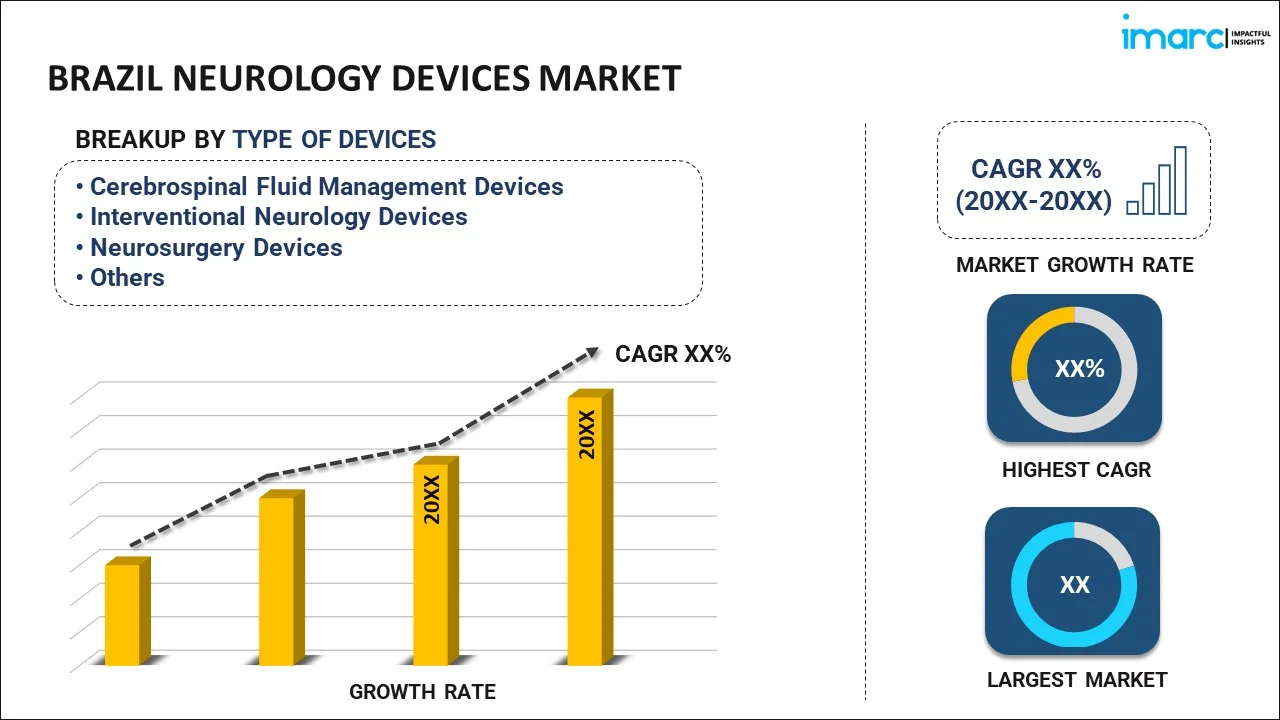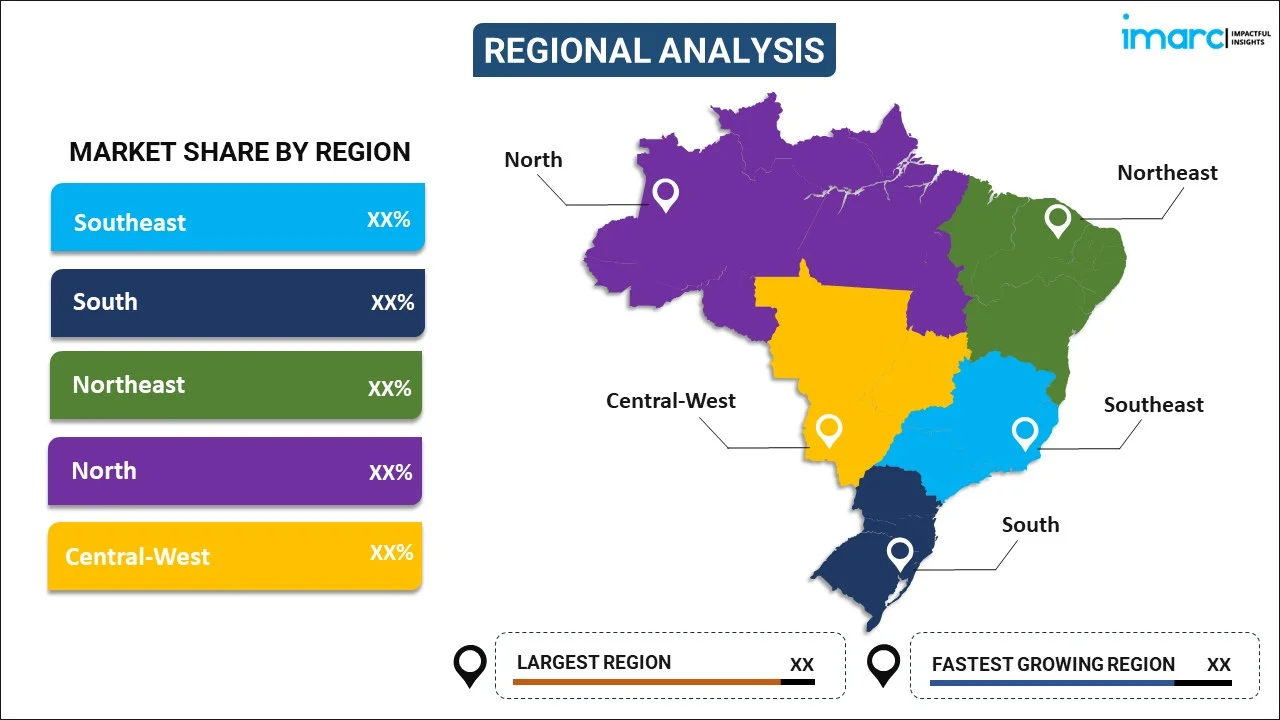
Brazil Neurology Devices Market Report by Type of Device (Cerebrospinal Fluid Management Devices, Interventional Neurology Devices, Neurosurgery Devices, Neurostimulation Devices, and Others), and Region 2024-2032
Market Overview:
Brazil neurology devices market size is projected to exhibit a growth rate (CAGR) of 4.61% during 2024-2032. The rising incidence of neurological disorders, increased investment in healthcare infrastructure, and ongoing research and development (R&D) in the neurology field represent some of the key factors driving the market.
|
Report Attribute
|
Key Statistics
|
|---|---|
|
Base Year
|
2023 |
|
Forecast Years
|
2024-2032
|
|
Historical Years
|
2018-2023
|
| Market Growth Rate (2024-2032) | 4.61% |
Neurology devices encompass a diverse array of medical instruments and technologies designed for the diagnosis, treatment, and monitoring of neurological disorders and conditions affecting the central and peripheral nervous systems. These devices play a critical role in the field of neurology, facilitating the assessment and management of conditions, such as epilepsy, Parkinson's disease, Alzheimer's disease, and traumatic brain injuries, among others. Neurology devices include diagnostic tools like electroencephalography (EEG) machines for monitoring brain activity, electromyography (EMG) devices for assessing muscle and nerve function, neurostimulation devices to treat disorders like epilepsy, and neurosurgical instruments for precise interventions. These technologies enable healthcare professionals to gain insights into brain and nervous system function, aiding in the diagnosis of neurological disorders and the development of treatment strategies, ultimately improving the quality of life for patients suffering from various neurological conditions. The ongoing advancement of neurology devices and technology continues to drive progress in the field, allowing for more accurate diagnosis and effective management of neurological disorders.
Brazil Neurology Devices Market Trends:
The increasing burden of neurological disorders in the country, including conditions like Alzheimer's disease, epilepsy, and stroke, is one of the key factors driving the market growth. In line with this, the aging population and numerous lifestyle factors have led to a rise in neurological ailments, thus fueling the demand for neurology devices for diagnosis, monitoring, and treatment. Moreover, continuous advancements improving the efficiency, preciseness, and accessibility of neurology devices and the introduction of high-resolution brain imaging equipment, non-invasive neuromodulation devices, and mobile health applications are strengthening the market growth. Besides this, growing healthcare expenditure in Brazil, both from the government and the private sector, has resulted in improved access to neurology services and devices, creating a favorable outlook for market expansion. Concurrently, the rise in awareness and understanding of neurological disorders among the general population and healthcare practitioners has led to more frequent diagnosis and management of these conditions, which, in turn, is impelling the demand for neurology devices. In addition to this, the economic development in Brazil has contributed to higher disposable incomes, allowing more individuals to access specialized neurology care and advanced neurology devices, contributing to the market growth. Furthermore, favorable government initiatives, such as extensive investments in research and development (R&D) and the facilitation of partnerships between medical device manufacturers and healthcare institutions, have stimulated the growth of the neurology devices market. Apart from this, the COVID-19 pandemic has further heightened the adoption of remote healthcare monitoring and telemedicine, which rely on neurology devices for remote neurological assessments and consultations, bolstering the market growth.
Brazil Neurology Devices Market Segmentation:
IMARC Group provides an analysis of the key trends in each segment of the market, along with forecasts at the country level for 2024-2032. Our report has categorized the market based on type of device.
Type of Device Insights:

- Cerebrospinal Fluid Management Devices
- Interventional Neurology Devices
- Interventional/Surgical Simulators
- Neurothrombectomy Devices
- Carotid Artery Stents
- Embolic Coils
- Support Devices
- Neurosurgery Devices
- Neuroendoscopy
- Stereotactic Systems
- Aneurysm Clips
- Others
- Neurostimulation Devices
- Spinal Cord Stimulation Devices
- Deep Brain Stimulation Devices
- Sacral Nerve Stimulation Devices
- Others
- Others
The report has provided a detailed breakup and analysis of the market based on the type of device. This includes cerebrospinal fluid management devices, interventional neurology devices (interventional/surgical simulators, neurothrombectomy devices, carotid artery stents, embolic coils, and support devices), neurosurgery devices (neuroendoscopy, stereotactic systems, aneurysm clips, and others), neurostimulation devices (spinal cord stimulation devices, deep brain stimulation devices, sacral nerve stimulation devices, and others), and others.
Regional Insights:

- Southeast
- South
- Northeast
- North
- Central-West
The report has also provided a comprehensive analysis of all the major regional markets, which include Southeast, South, Northeast, North, and Central-West.
Competitive Landscape:
The market research report has also provided a comprehensive analysis of the competitive landscape in the market. Competitive analysis such as market structure, key player positioning, top winning strategies, competitive dashboard, and company evaluation quadrant has been covered in the report. Also, detailed profiles of all major companies have been provided.
Brazil Neurology Devices Market Report Coverage:
| Report Features | Details |
|---|---|
| Base Year of the Analysis | 2023 |
| Historical Period | 2018-2023 |
| Forecast Period | 2024-2032 |
| Units | US$ Million |
| Scope of the Report | Exploration of Historical and Forecast Trends, Industry Catalysts and Challenges, Segment-Wise Historical and Predictive Market Assessment:
|
| Type of Devices Covered |
|
| Regions Covered | Southeast, South, Northeast, North, Central-West |
| Customization Scope | 10% Free Customization |
| Report Price and Purchase Option | Single User License: US$ 3699 Five User License: US$ 4699 Corporate License: US$ 5699 |
| Post-Sale Analyst Support | 10-12 Weeks |
| Delivery Format | PDF and Excel through Email (We can also provide the editable version of the report in PPT/Word format on special request) |
Key Questions Answered in This Report:
- How has the Brazil neurology devices market performed so far and how will it perform in the coming years?
- What has been the impact of COVID-19 on the Brazil neurology devices market?
- What is the breakup of the Brazil neurology devices market on the basis of type of device?
- What are the various stages in the value chain of the Brazil neurology devices market?
- What are the key driving factors and challenges in the Brazil neurology devices?
- What is the structure of the Brazil neurology devices market and who are the key players?
- What is the degree of competition in the Brazil neurology devices market?
Key Benefits for Stakeholders:
- IMARC’s industry report offers a comprehensive quantitative analysis of various market segments, historical and current market trends, market forecasts, and dynamics of the Brazil neurology devices market from 2018-2032.
- The research report provides the latest information on the market drivers, challenges, and opportunities in the Brazil neurology devices market.
- Porter's five forces analysis assist stakeholders in assessing the impact of new entrants, competitive rivalry, supplier power, buyer power, and the threat of substitution. It helps stakeholders to analyze the level of competition within the Brazil neurology devices industry and its attractiveness.
- Competitive landscape allows stakeholders to understand their competitive environment and provides an insight into the current positions of key players in the market.
Need more help?
- Speak to our experienced analysts for insights on the current market scenarios.
- Include additional segments and countries to customize the report as per your requirement.
- Gain an unparalleled competitive advantage in your domain by understanding how to utilize the report and positively impacting your operations and revenue.
- For further assistance, please connect with our analysts.
 Inquire Before Buying
Inquire Before Buying
 Speak to an Analyst
Speak to an Analyst
 Request Brochure
Request Brochure
 Request Customization
Request Customization




.webp)




.webp)












